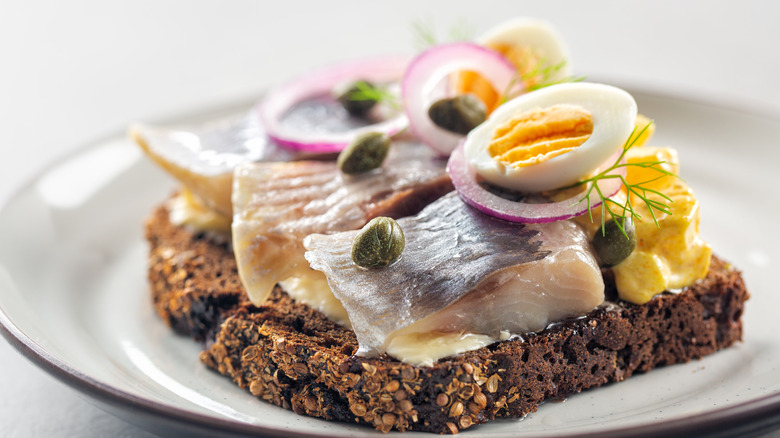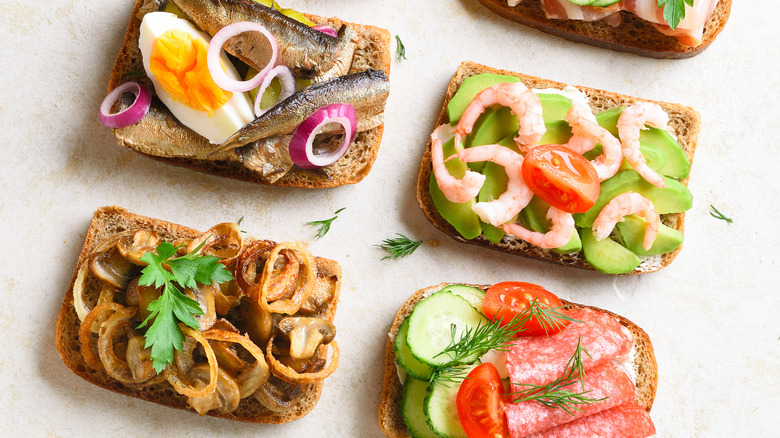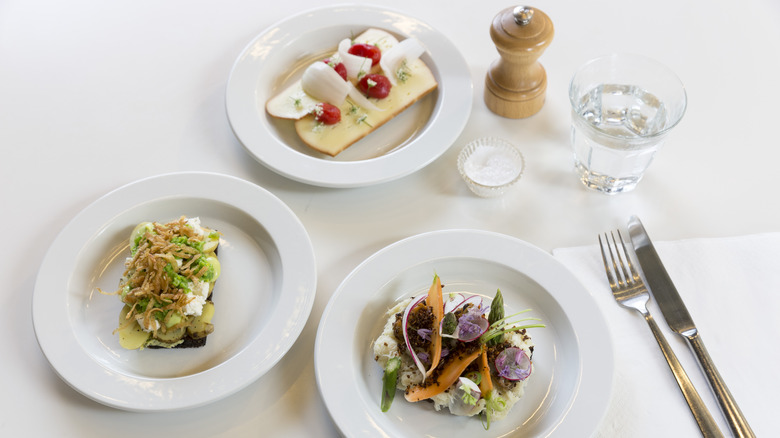Smørrebrød: The Scandinavian Open-Faced Sandwich You Should Know About
In Northern Europe sits a collection of countries known as Scandinavia. Bordered by the Baltic, North, and Norwegian Seas, Scandinavia encompasses Norway, Sweden, Finland, Denmark, Iceland, sometimes Greenland, and some smaller surrounding islands. These countries boast an impressive amount of natural resources from forests and saltwater seas and have given the culinary world some wonderful contributions. Gravlax, skyr (Icelandic yogurt), aebleskiver (sweet pancake balls), hasselback potatoes, and Swedish meatballs all hail from this part of the world.
It may not be a household name, but smørrebrød is beloved by those in the know and certainly by the people of Denmark where it is considered a national dish. Truthfully, smørrebrød can appear to be a little fussy at first glance because it is almost always beautifully put together, as it should be. Underneath it all, it is a simple dish, just presented to feed the eyes first, as any good meal should. At its most basic, smørrebrød — pronounced smore-eh-brohd — is Danish bread with butter. But it is most recognizable as an open-faced sandwich consisting of Danish rye bread called rugbrød topped with countless ingredients but most often consisting of a base ingredient of fish, meat, or cheese.
Who discovered smørrebrød?
There are a couple of stories about how smørrebrød first came to be. Some believe it was farmers who first thought up the dish. They needed a portable meal to bring with them to eat in the fields and packed a variety of leftover foods from the previous night's dinner. In lieu of plates — this was long before the invention of paper plates or lunch boxes — the farmers would place the food on slices of the dense rye bread from their kitchens and eat off them. Initially, the bread was discarded but soon it was discovered that the bread itself offered more calories and flavor and it became part of the meal.
It is also believed that smørrebrød was an invention of the 19th century during the rise of industrialization in Denmark. Danish citizens found steady work in factories which required them to be onsite throughout the day and not able to go home for lunch. For their midday meal, they packed open-faced sandwiches of rugbrød spread with butter or animal fat topped with meats, fish, or dinner leftovers. By the late 1800s, smørrebrød was being offered in both pubs and restaurants, usually accompanied by beer or aquavit.
The many elements of smørrebrød
To make traditional smørrebrød, the aforementioned rugbrød is a vital ingredient, although some modern chefs and restaurants also use white and brioche bread for certain variations. Rugbrød is a dense, dark bread that is both sour and sweet. It has a sturdy structure thanks in part to the generous amount of seeds and rye berries inside and has the perfect texture to hold up to the variety of toppings that go onto smørrebrød. A layer of butter is always spread over the rugbrød, not just for flavor, but to act as a layer that keeps the juices and moisture from the rest of the ingredients from seeping through to the bread, making it soggy. Many times, paté, goose fat, or other rich spreads are used instead of butter.
Ideally, the toppings should be traditionally Scandinavian to honor the dish's area of birth. This is why it's common to see pickled herring, small shrimp, boiled eggs, and salmon on top of smørrebrød. But the toppings certainly are not limited to these elements. Like French tartines or Italian bruschetta, you really can put almost anything on smørrebrød, even last night's leftovers as those Danish factory workers did. Aside from meat or fish, vegetables can top the bread and butter such as pickled beets, onions, kale, avocado, potatoes, and cucumber pickles. And smørrebrød wouldn't be complete without garnishes like fresh herbs, nuts, and horseradish. In essence, smørrebrød can be an entire meal on top of a single slice of bread.
Eat like the Danish do
Traditionally, smørrebrød is eaten for lunch, but it's not uncommon to enjoy the dish as a light dinner. Whenever you choose to partake of this Danish delight, just know it comes with some unwritten rules. As tempting as it may be to pick up this open-faced sandwich and eat it like a pizza, you will definitely out yourself as a tourist if you do so. Smørrebrød is eaten with a knife and fork, mostly because they tend to be piled high with ingredients. It is not uncommon (and somewhat expected) to order a variety of smørrebrød, not just one single flavor choice. If you do, be aware that the order in which you eat them matters.
Customarily, smørrebrød with herring is eaten first, then ones with any other fish. When those are finished, move on to meat-topped ones, and finally, end with cheese smørrebrød. The order has to do with flavors not competing with each other on your palate.
To keep everything from toppling over if you make the dish yourself, simply layer the thin toppings on the bread first, followed by the bigger ones, and the garnishes. Traditional smørrebrød also doesn't mix meats or proteins, so stick to fish or meat or cheese, not a combination of them. And always remember that smørrebrød should be beautiful, full of color, and look like they were put together with care. It's all part of having a satisfying meal for more than your belly.



